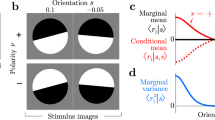Abstract
This paper studies the behavior of a large body of neurons in the continuum limit. A mathematical characterization of such systems is obtained by approximating the inverse input-output nonlinearity of a cell (or an assembly of cells) by three adjustable linearized sections. The associative spatio-temporal patterns for storage in the neural system are obtained by using approaches analogous to solving space-time field equations in physics. A noise-reducing equation is also derived from this neural model. In addition, conditions that make a noisy pattern retrievable are identified. Based on these analyses, a visual cortex model is proposed and an exact characterization of the patterns that are storable in this cortex is obtained. Furthermore, we show that this model achieves pattern association that is invariant to scaling, translation, rotation and mirror-reflection.
Similar content being viewed by others
References
Amari SI (1972) Characteristics of random nets of analog neuron-like elements. IEEE Trans Syst Man Cybern 2:1443–1463
Amari SI (1975) Homogeneous nets of neuron-like elements. Biol Cybern 17:211–220
Amari SI (1977) Dynamics of pattern formation in lateral-inhibition type neural fields. Biol Cybern 27:77–87
Amari SI, Arbib MA (1977) Competition and cooperation in neural nets. In Metzler J (eds) Systems neuroscience. Academic Press, New York, pp 119–165
Anderson JA (1968) A memory storage model utilizing spatial correlation function. Kybernetik 5:113–119
Beaulieu C, Colonnier M (1983) The number of neurons in the different laminae of the binocular and monocular regions of area 17 in the cat. J Comp Neurol 217:337–344
Beaulieu C, Colonnier M (1985) A laminar analysis of round-asymmetrical and flat-asymmetrical synapses on spins, dendritic trunks and cell bodies in area 17 of the cat. J Comp Neurol 231:180–189
Blinkov SM, Glezer II (1968) The human brain in figures and tables. Plenum Press, New York
Bochner S, Chandrasekharan K (1949) Fourier transforms. University Press, Princeton USA
Caianiello ER (1961) Outline of a theory of thought-processes and thinking machines. J Theor Biol 2:204–235
Chang HJ, Ghosh J, Liano K (1992) A macroscopic model of neural ensembles: Learning-induced oscillations in a cell assembly. Int J Neural Systems 3:179–198
Cowan JD (1967) A mathematical theory of central nervous activity, Thesis, University of London
Eillias SA, Grossberg S (1975) Pattern formation, contrast control and oscillations in the short-term memory of shunting on-center off-surround networks. Biol Cybern 20:69–98
Ermentrout GB, Cowan JD (1979) A mathematical theory of visual hallucination patterns. Biol Cybern 34:137–150
Ermentrout GB, Cowan JD (1980) Large scale spatially organized activity in neural nets. SIAM J Appl Math 38:1–21
Ermentrout B, Campbell J, Oster G (1986) A model for patterns based on neural activity. Veliger 28:369–388
Fukushima K (1980) Neocognitron: A self-organization neural network model for a mechanism of pattern recognition unaffected by a shift in position. Biol Cybern 36: 192–202
Hochstein S, Spitzer H (1985) One, few, infinity: linear and nonlinear processing in the visual cortex. In: Rose D, Dobson VG (eds) Models of the visual cortex. John Wiley, New York, pp 341–350
Kohonen T (1989) Self-organization and associative memory. Springer, Berlin Heidelberg New York
Porter D, Stirling DSG (1990) Integral equations. Cambridge University Press, Cambridge, USA
Schwartz EL (1980) Computational anatomy and functional architecture of striate cortex: A spatial mapping approach to perceptual coding. Vision Res 20:645–669
Smirnov VI (1964) Integral equations and partial differential equations. Addison-Wesley, Reading
Stanley JC (1976) Simulation studies of a temporal sequence memory model. Biol Cyber 24:121–137
Thomas E, Patton P, Wyatt RE (1991) A computational model of the vertical anatomical organization of primary visual cortex. Biol Cybern 65:189–202
Traub RD, Miles R, Wong RKS (1989) Model of the origin of rhythmic population oscillations in the hippocampal slice. Science 243:1319–1325
Wehmeier U, Dong D, Koch C, Van Essen D (1989) Modeling the mammalian visual system. In: Koch C, Segev I (eds) Methods in neuronal modeling, from synapses to networks. MIT Press, Cambridge, pp 335–359
Willner BE, Miranker ML, Lu CP (1990) Neural organization of the locomotive oscillator. Technical Report RC 16390 (No. 72765), IBM Research Report, TJ Watson Research Center
Wilson HR, Cowan JD (1973) A mathematical theory of the functional dynamics of cortical and thalamic nervous tissue. Kybernetik 13:55–80
Author information
Authors and Affiliations
Rights and permissions
About this article
Cite this article
Chang, HJ., Ghosh, J. Pattern association and retrieval in a continuous neural system. Biol. Cybern. 69, 77–86 (1993). https://doi.org/10.1007/BF00201410
Received:
Accepted:
Issue Date:
DOI: https://doi.org/10.1007/BF00201410




